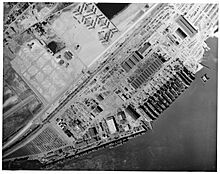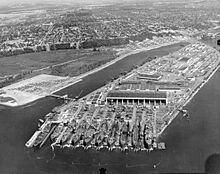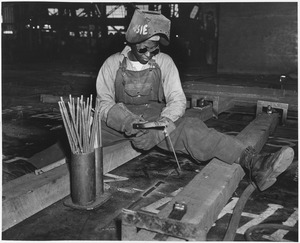Kaiser Shipyards facts for kids
The Kaiser Shipyards were a group of seven huge shipbuilding yards on the West Coast of the United States during World War II. These shipyards were owned by the Kaiser Shipbuilding Company, which was started by an American businessman named Henry J. Kaiser. He began the company around 1939 to help build many ships for the United States Maritime Commission.
Kaiser's shipyards were very important during the war. They built 1,490 ships, which was about 27 percent of all the ships the Maritime Commission needed. Henry Kaiser was famous for finding new and faster ways to build ships. His yards built ships in about two-thirds of the usual time and for only a quarter of the cost compared to other shipyards. For example, a Liberty ship could often be put together in just over two weeks. One was even built in less than five days!
Four of the Kaiser Shipyards were located in Richmond, California, and were known as the Richmond Shipyards. The other three were in the Pacific Northwest, along the Columbia River and Willamette River. These included the Oregon Shipbuilding Corporation and the Swan Island Shipyard in Portland, Oregon, and the Vancouver Shipyard in Vancouver, Washington.
After World War II ended, the Kaiser Shipyards closed down. Today, the Rosie the Riveter/World War II Home Front National Historical Park is located at the site of one of the Richmond shipyards. It opened on October 25, 2000.
History of the Shipyards
Henry Kaiser had already been building cargo ships in the 1930s. He worked with other companies like Todd Pacific Shipyards. When the British government, who were already fighting Germany, ordered more ships, Kaiser decided to build his first shipyard in Richmond in December 1940.
In April 1941, the Maritime Commission asked Kaiser to build another shipyard just for Liberty ships. After the attack on Pearl Harbor in December 1941, the United States joined the war. Kaiser then started two more shipyards. These new yards built troop transport ships and tank landing ships (LSTs). Henry Kaiser's son, Edgar Kaiser, Sr, became the Vice-President and General Manager of these shipyards.
Together, the four Kaiser Shipyards in Richmond built 747 ships. This included many famous Liberty ships and Victory ships. These ships carried general cargo, military supplies, weapons, and equipment. The Richmond yards built more ships than any other shipbuilding complex in the United States. Only one of these ships, the Red Oak Victory, still exists today. Other Liberty ships built elsewhere, like the Jeremiah O'Brien in San Francisco, are now museum exhibits.
In 1943, the Kaiser shipyards also built Casablanca-class escort carriers. These were smaller aircraft carriers. Kaiser promised to build 16 carriers by 1944. He encouraged his workers to build even more, using the slogan "18 or more by 44."
Amazing Shipbuilding Records
Kaiser Shipyards set several amazing records for speed:
- The Liberty ship SS Robert E. Peary was put together in less than five days. This was part of a special competition among different shipyards.
- At the Oregon Shipbuilding Yard near Portland, the Victory ship SS Joseph N. Teal was built in just ten days in the fall of 1942.
- The Oregon Shipbuilding Yards alone were responsible for building 455 ships.
Henry Kaiser brought workers from all over the United States to his shipyards. He hired many women and minority groups, which was very important during the war.
One shipyard, the Walsh-Kaiser Company, was located in Fields Point in Providence, Rhode Island. After the war, this shipyard was closed and sold. A Swedish ship owner bought it, took it apart, and rebuilt it in Sweden!
See also
- Kaiser Permanente, a healthcare company also started by Henry J. Kaiser
- Marinship
- Shipyard Railway, a railway that took workers to the Kaiser Shipyards in Richmond, California
- Vanport, Oregon






